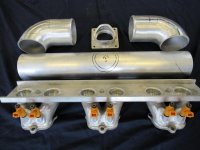HealeyPassion
Jedi Warrior
Offline
Healey guys,
I haven't posted in years, but thought there might be some interest in my long term EFI AH project. This is (or will be when I get it done) the second EFI Healey I've built. I took a different approach on this one. I'm sure traditionalists will be unhappy with it, I also love originals, but for a moment think "evolution." Please no hate mail, I get it if you don't like what I've done. In my defense, I have kept all the original parts in plastic containers for posterity... "no animals were harmed...".
Here is a link to short video (1 1/2 minutes) taken Saturday. You may notice other cameras setup... so, yes, I have more footage but this one was thrown together to show the engine after about 15 minutes of tune.I haven't posted in years, but thought there might be some interest in my long term EFI AH project. This is (or will be when I get it done) the second EFI Healey I've built. I took a different approach on this one. I'm sure traditionalists will be unhappy with it, I also love originals, but for a moment think "evolution." Please no hate mail, I get it if you don't like what I've done. In my defense, I have kept all the original parts in plastic containers for posterity... "no animals were harmed...".
The engine has a bit over 100,000 miles on it and never been rebuilt. The ECU is a MegaSquirt 2 3.4.3 with sensors for manifold absolute pressure (MAP), water temp., air intake temp., throttle position, wide band O2 and idle air control. The distributor is a GM HEI (high energy ignition) EFI unit that was machined to fit, so it connects to the ECU and gives the ECU full visibly of the RPM and timing advance (the curve can be set by the ECU). The fuel pressure regulator is set to 45 psi and is mounting in a very temporary position. The throttle body is a Mustang 65mm unit which may be a bit too large, we're going to be testing a 60mm TB shortly. There is much to do and the engine will be completely rebuilt before final tuning. The wiring test harness will obviously be replaced with a permanent harness after the engine rebuild.
So, this effort was just intended to check all the electronics and establish a baseline tune before the complete rebuild.
The EFI intake has been a work in progress for about 10/11 months. The custom designed intake has 6 injectors, one injector for each cylinder ... so a multi-port injection system. I began with Weber manifolds and went from there. The beautiful manifold fabrication is the work of Chris Mack. I should mention that Chris did the beautiful header/exhaust system that you can't see in the video. The wiring and tuning, as seen in the video, are the work of EFI guru Ric Navarro.
So, this effort was just intended to check all the electronics and establish a baseline tune before the complete rebuild.
The EFI intake has been a work in progress for about 10/11 months. The custom designed intake has 6 injectors, one injector for each cylinder ... so a multi-port injection system. I began with Weber manifolds and went from there. The beautiful manifold fabrication is the work of Chris Mack. I should mention that Chris did the beautiful header/exhaust system that you can't see in the video. The wiring and tuning, as seen in the video, are the work of EFI guru Ric Navarro.
It was an exciting day for me as I've spend a year or so getting to this point.
Cheers,
Steve
Last edited:

 Hi Guest!
Hi Guest!

 smilie in place of the real @
smilie in place of the real @
 Pretty Please - add it to our Events forum(s) and add to the calendar! >>
Pretty Please - add it to our Events forum(s) and add to the calendar! >> 

